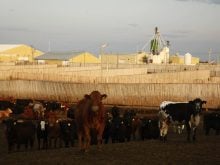This cattle market information is selected from the weekly report from Canfax, a division of the Canadian Cattlemen’s Association. More market information, analysis and statistics are available by becoming a Canfax subscriber by calling 403-275-5110 or at www.canfax.ca.
fed cattle stronger
The Canfax weighted average steer price was $178.93 per hundredweight, up $1.62, and heifers were $178.20, up $3.20.
Most sales went to one Alberta packer and will be delivered within two weeks.
American buyer interest was light, helping to explain a pull back in bids from Wednesday to Thursday.
Read Also

Huge Black Sea flax crop to provide stiff competition
Russia and Kazakhstan harvested huge flax crops and will be providing stiff competition in China and the EU.
The weaker prices have cattle staying on feed longer with many yearlings on feed for 150-180 days.
Carcass weights remain heavy, but cattle are grading exceptionally well for the time of year.
Prime and AAA as a percent of all A grades was almost 67 percent compared to about 58 percent last year.
One Alberta plant has been operating only four days a week since the start of the year, likely in a strategy to build market-ready supply and to keep cooler inventories lean.
Western Canadian weekly fed slaughter volumes have yet to surpass 30,000 head, but exports are up over last year.
Slaughter cows down
D1, D2 cows ranged $100-$115 per cwt. to average $107.70, down $2.88. D3s ranged $88-$105 to average $96.29, down $1.31.
Rail grade cows were $210-$215 delivered.
Butcher bulls dipped $1.70 average $132.69.
Weekly non-fed slaughter in the West to Jan. 23 rose to 8,077 head.
Slaughter is up one percent this year. Weekly exports to Jan. 16 rose 10 percent at 5,302 but are down 19 percent for the year.
Feeders mixed
Average steer prices were mostly steady, while heifer prices rose more than $2 per cwt.
Stocker and feeder demand was mixed. Calves lighter than 600 lb. rose and feeders heavier than 800 lb. fell.
Feedlots are fairly full, and U.S. buyer interest is lackluster.
Auction volume rose 27 percent to 28,446 head.
Weekly exports to Jan. 16 were only 406 head.
The year’s exports are down 80 percent at 1,819 head. The Alberta feeder basis is strong, which is limiting exports.
Calf prices usually strengthen toward spring, while feeders heavier than 700 lb. typically trend lower until February or March.
The softer summer fed market could potentially pressure prices for larger yearlings.
Beef weakens
Beef demand is normally slow this time of year.
The Choice cutout fell $3.54 to US$220.12 per cwt. and Select fell $4.25 to $215.43.
Cutouts typically hit bottom mid-February before spring demand picks up.
Canadian prices were unavailable.
















